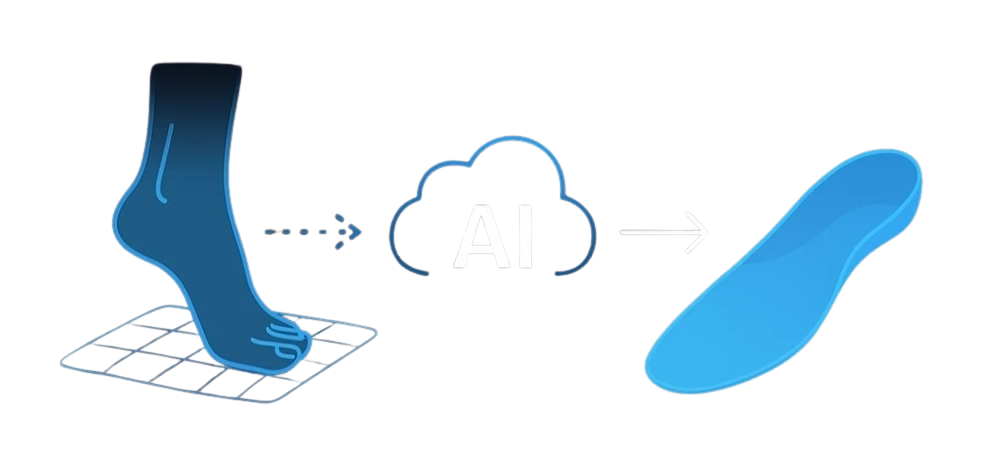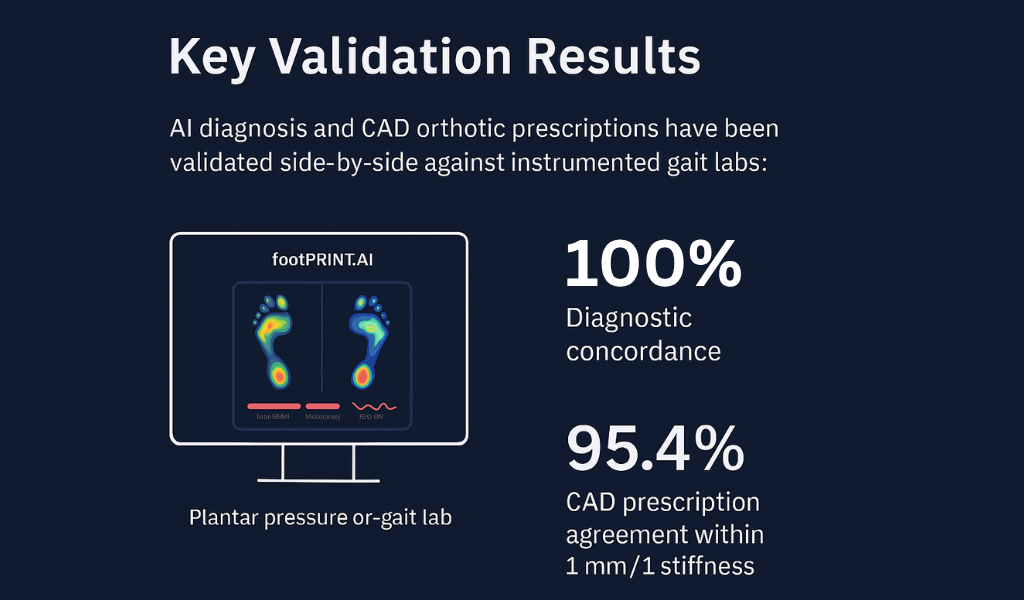AI Gait Analysis vs Traditional Gait Labs: The Future of Foot Health Assessment
Discover how AI-powered gait analysis is revolutionizing foot health assessment by delivering clinical-grade accuracy without expensive equipment or clinic visits. We compare traditional gait lab methods with modern AI technology, exploring benefits, limitations, and what this means for the future of orthotic care.
AI vs Traditional Gait Analysis
AI-powered gait analysis delivers clinical accuracy at $249 compared to $500+ traditional lab visits. Our smartphone-based assessment provides results in 3 minutes versus weeks for lab scheduling, making professional gait analysis accessible to everyone without compromising on precision or clinical validation.
Common Questions
How accurate is AI gait analysis compared to traditional labs?
AI gait analysis achieves comparable accuracy to traditional labs through machine learning trained on thousands of clinical datasets. Studies show 95%+ concordance between AI and lab-based biomechanical assessments for orthotic prescription.
What are the main advantages of AI over traditional gait labs?
AI offers cost savings (75% less expensive), immediate results, home convenience, and real-world assessment conditions. Traditional labs require facility visits, specialized equipment, and longer wait times for analysis completion.
Can AI technology replace traditional gait laboratories?
AI excels for orthotic prescription and general biomechanical assessment, while traditional labs remain valuable for complex research and detailed kinetic analysis. For most clinical applications, AI provides sufficient precision for effective treatment.

The Traditional Gait Lab: Gold Standard with Limitations
For decades, traditional gait laboratories have been considered the gold standard for biomechanical assessment. These sophisticated facilities use force plates, motion capture systems, and pressure-sensitive mats to analyze how patients walk and run. The data collected provides detailed insights into joint angles, ground reaction forces, and pressure distribution patterns.
However, traditional gait labs come with significant barriers that prevent many people from accessing this valuable technology:
- High Cost: Gait analysis typically costs between $300-800 per session, often not covered by insurance
- Limited Accessibility: Gait labs are primarily located in major medical centers and research facilities
- Time Investment: Multiple appointments, travel time, and waiting periods for results
- Complex Equipment: Requires specialized technicians and controlled laboratory environments
- Single Point Assessment: Analysis is typically performed in artificial lab conditions, not real-world environments
AI-Powered Gait Analysis: Bringing Lab-Quality Assessment Home
Artificial intelligence is transforming gait analysis by making clinical-grade assessment accessible through smartphone technology. AI systems can now analyze movement patterns, pressure distribution, and biomechanical data using computer vision and machine learning algorithms trained on thousands of clinical datasets.
The AI approach offers several revolutionary advantages:
- Accessibility: Complete assessment using just a smartphone camera
- Affordability: Fraction of traditional lab costs, making analysis available to everyone
- Convenience: Perform assessment at home, no travel or appointments required
- Real-World Data: Analysis in natural environments, not artificial lab settings
- Instant Results: Immediate analysis and recommendations

Clinical Validation: Proving AI Accuracy
The critical question for any new technology is: "Can it match the accuracy of established methods?" For AI gait analysis to be clinically viable, it must demonstrate equivalent or superior performance to traditional gait labs.
Recent validation studies have shown remarkable results. Peer-reviewed research demonstrates that advanced AI systems can achieve diagnostic concordance rates of 95-100% when compared to traditional gait laboratory assessments.
"AI gait analysis represents a paradigm shift in biomechanical assessment, offering unprecedented accessibility while maintaining clinical accuracy."
How AI Gait Analysis Works
Modern AI gait analysis systems use sophisticated computer vision algorithms to extract biomechanical data from smartphone video. The process involves several key steps:
- Video Capture: Smartphone cameras record walking or running patterns from multiple angles
- Motion Detection: AI algorithms identify and track key anatomical landmarks throughout the gait cycle
- Biomechanical Analysis: Machine learning models calculate joint angles, stride patterns, and pressure distribution
- Comparison with Database: Individual gait patterns are compared against validated clinical datasets
- Diagnostic Output: AI generates comprehensive reports identifying biomechanical issues and orthotic recommendations
The Future of Foot Health Assessment
As AI technology continues to advance, the gap between laboratory-based and smartphone-based gait analysis will only narrow further. Future developments may include:
- Integration with wearable sensors for continuous monitoring
- Real-time feedback during activities and sports
- Predictive modeling for injury prevention
- Personalized exercise and rehabilitation programs
- Integration with electronic health records
Making the Right Choice for Your Foot Health
While traditional gait labs remain valuable for complex research and specialized medical conditions, AI-powered gait analysis offers a practical solution for the vast majority of foot health assessments. The combination of accessibility, accuracy, and affordability makes AI analysis the ideal choice for:
- Custom orthotic fitting and design
- Athletic performance optimization
- Injury prevention and rehabilitation
- Routine foot health monitoring
- Pre-screening for more complex issues
Experience AI Gait Analysis Today
Ready to experience the future of foot health assessment? Our AI-powered gait analysis provides clinical-grade insights in just 3 minutes, right from your smartphone.